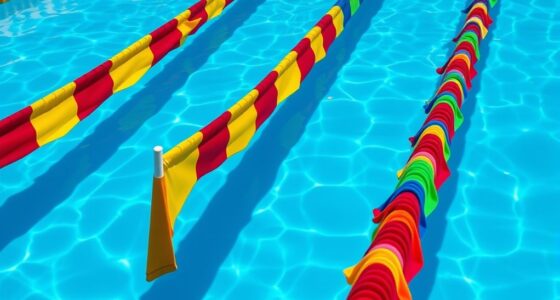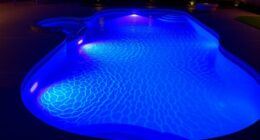In indoor lap pools, proper ventilation and dehumidification are key to keeping the environment healthy and comfortable. You should guarantee fresh air circulates to reduce indoor pollutants and maintain air quality, while controlling humidity prevents mold, corrosion, and excess moisture. Using effective ventilation systems with dehumidifiers works best in managing moisture levels and air cleanliness. Continue exploring to discover how these systems work together for a safe, inviting swimming space.
Key Takeaways
- Proper ventilation maintains fresh air, reduces pollutants, and controls humidity, preventing mold and corrosion in indoor lap pools.
- Adequate dehumidification works with ventilation to regulate indoor moisture levels and enhance comfort.
- Effective water chemistry management minimizes evaporation, lowering humidity and easing ventilation system load.
- Integrated ventilation and dehumidification systems improve air quality, safety, and overall environment for swimmers.
- Proper lighting complements climate control, ensuring visibility, safety, and a pleasant indoor pool atmosphere.

Indoor lap pools offer a convenient and private solution for swimmers who want to train year-round regardless of the weather. However, maintaining a comfortable and healthy environment inside your pool space requires careful attention to ventilation and dehumidification. Proper ventilation ensures fresh air circulation, reducing humidity levels and preventing the buildup of indoor pollutants. When designing your indoor pool area, pay close attention to lighting design, as it not only influences the ambiance but also impacts air quality. Adequate lighting can help you see clearly, making it easier to monitor water conditions and detect any issues early. Combining good lighting with effective ventilation creates an inviting space where you can focus on your swim without distraction or discomfort.
One of the key challenges with indoor pools is managing water chemistry. Poor water chemistry can lead to increased evaporation, which raises humidity levels inside your pool area, making ventilation more difficult. By maintaining proper water chemistry—balancing pH, alkalinity, and sanitizer levels—you help control evaporation rates and minimize excess moisture. This creates a more stable environment, reducing the workload on your ventilation system and preventing problems like mold or corrosion. When water chemistry is optimized, you also reduce the likelihood of foul odors, which can linger and diminish the comfort of your pool area. Regular testing and adjustments are essential to keep water chemistry in check, ensuring that the environment remains safe, clean, and inviting. Additionally, understanding humidity control methods can help you select the most effective dehumidification solutions for your space.
Effective ventilation and dehumidification are closely interconnected. A well-designed ventilation system not only brings in fresh air but also exhausts humid indoor air, preventing condensation and mold growth. Consider installing dehumidifiers that work in tandem with your ventilation system to control moisture levels precisely. This combination helps protect your pool equipment and structure while maintaining a comfortable atmosphere for swimmers. It’s also important to think about air filtration, which removes airborne contaminants and improves overall air quality. When all these elements—lighting design, water chemistry, ventilation, and dehumidification—work together harmoniously, you create an indoor lap pool environment that’s safe, hygienic, and enjoyable year-round.
Frequently Asked Questions
How Often Should Ventilation Systems Be Inspected and Maintained?
You should inspect and maintain your ventilation systems at least quarterly, following a regular ventilation schedule. Use detailed maintenance checklists to guarantee all components function properly, including filters, fans, and ducts. Consistent inspections help prevent mold, humidity issues, and odor buildup. Regular upkeep not only prolongs system life but also maintains air quality, ensuring a safe, comfortable environment for swimmers and staff alike.
What Are the Energy Costs Associated With Dehumidification Systems?
You should expect dehumidification systems to increase your energy costs, but a thorough cost analysis helps identify options that improve energy efficiency. These systems typically use significant power, especially in high humidity environments, so upgrading to energy-efficient models can reduce expenses. Regular maintenance ensures maximum performance, saving you money in the long run. Balancing effective moisture control with energy efficiency is key to managing costs while keeping your indoor pool comfortable.
Can Ventilation Improve Indoor Air Quality During Peak Usage?
Sure, ventilation can actually improve indoor air quality during peak use—who would’ve thought? By increasing air exchange and incorporating effective air filtration, you reduce humidity and remove chlorine smells and airborne contaminants. It might seem like a hassle, but during busy times, proper ventilation guarantees fresh air circulates, making the environment healthier and more comfortable for everyone. So, yes, good ventilation is your secret weapon for peak indoor air quality.
Are There Eco-Friendly Options for Dehumidification in Indoor Pools?
Yes, you can choose eco-friendly dehumidifiers like silica gel or renewable energy-powered systems to reduce your pool’s environmental impact. Sustainable ventilation options, such as energy recovery ventilators (ERVs), efficiently exchange indoor air while conserving energy. These solutions help maintain ideal humidity and air quality, all while minimizing your carbon footprint. By selecting eco-friendly dehumidifiers and sustainable ventilation, you create a healthier, greener indoor pool environment for everyone.
How Do Climate Variations Affect Ventilation and Dehumidification Needs?
You notice how climate impact changes everything, right? When temperatures rise or humidity levels shift, you must adjust your ventilation and dehumidification systems accordingly. In hot, humid weather, increased ventilation helps remove moisture and freshen the air, while cooler, dry conditions require less dehumidification. By staying responsive to climate variations, you guarantee your indoor lap pool remains comfortable, safe, and efficiently ventilated year-round.
Conclusion
Think of your indoor lap pool as a delicate ecosystem—you’re the gardener tending to its every breath and moisture. Proper ventilation and dehumidification are the sun and rain, balancing the environment so the pool thrives without chaos. By maintaining these systems, you create a harmonious space where water stays clear, air remains fresh, and the environment feels just right. Keep these essentials in check, and your indoor pool will be a serene oasis, always in perfect harmony.









